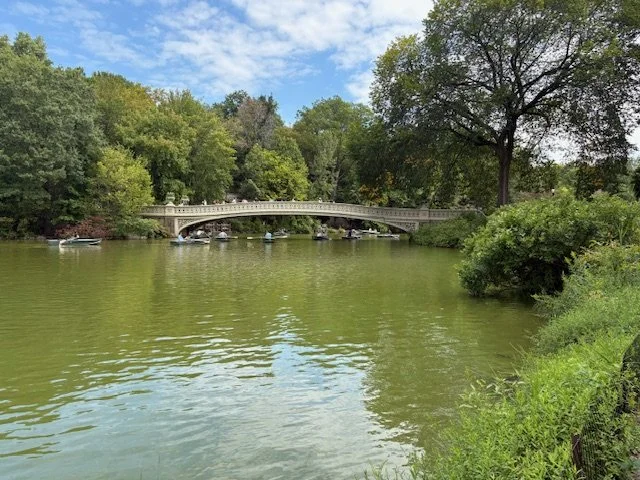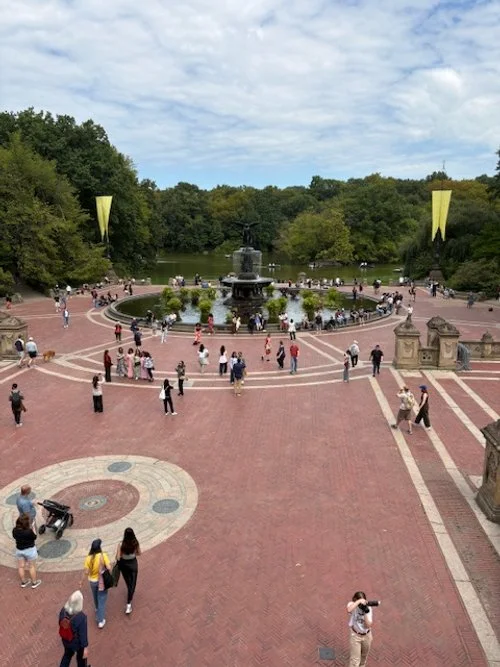A Greet That Was a Walk in the Park
When Deb Page contacted Big Apple Greeter to request a “Greeter’s Choice” experience for her, her partner Andrew, and daughter Mia, she happily agreed to volunteer Greeter Dore Hollander’s suggested visit to Central Park.
However, Deb wondered if there would be much to see. After four hours exploring just two of the park’s three sections with Dore, the family from the English Midlands understood why Central Park is beloved by New Yorkers who treasure the 843-acre green space between the Upper East Side and Upper West Side of Manhattan.
Dore, who has volunteered with the Central Park Conservancy since 2019, met Deb, Andrew, and Mia at the park entrance at 81st Street, directly across Central Park West from the 81st Street-Museum of Natural History station on the A, B, and C subway lines. Starting at one of the maps found throughout the park, Dore shared the park’s history before the group set out on their walk.
Landscape architects Frederick Law Olmstead and Calvert Vaux won a competition to design the park.
Construction began in the mid-1850s after existing structures on the land—including a majority-Black settlement called Seneca Village — were seized and razed. Initial park construction was completed in 1876. Olmstead and Vaux envisioned Central Park as a place for city dwellers to experience the peace and calm of nature. With that in mind, they ensured that the roads that run across Central Park from east to west were built underground. Those roads are still used by cars and buses today, leaving above-ground paths for strollers, runners, and bikers.
Water was another key element of the designers’ vision, and Central Park features a number of bodies of water ranging from the largest — the Reservoir, a favorite destination for runners — to the Lake at the south end of the park, which offers stunning views of midtown Manhattan.
Musicians frequently perform by Central Park’s lakes and ponds, as well as under the numerous bridges and arches found throughout the park.
John Lennon, who lived in the Dakota building at Central Park West and 72nd Street, visited the park frequently with his wife Yoko Ono.
After Lennon’s murder, Ono developed the concept for a memorial to Lennon in the park. Dore showed the visitors the resulting Strawberry Fields memorial, a garden of peace highlighted by a mosaic laid into the pavement with the word “Imagine” in the center—a gift from the city of Naples, Italy.
It was time for a break, so the group stopped at Tavern to Go, the Tavern on the Green restaurant’s grab-and-go window, for drinks and pastries.
There are several restaurants in Central Park, ranging from two outposts of the casual chain Le Pain Quotidien to the more formal Tavern on the Green. The latter’s building was originally designed by Vaux to house the sheep that grazed in the nearby Sheep Meadow. The sheep are long gone from the 15-acre space, and now it’s a popular location for sunbathing, reading, and contemplating the Manhattan skyline. The Great Lawn, another large open space located in the center of the park, is also a great place to relax, or to take in a softball game or concert.
Central Park offers plenty of attractions for visitors with children, including more than 20 playgrounds and a zoo featuring penguins, sea lions, and snow leopards.
Entrance to the zoo is by timed tickets, but animal lovers can stay as long as they like. Another animal favorite of both kids and adults is Balto, a bronze statue honoring an Alaskan husky who became famous as the lead sled dog on the final leg of an effort to transport diphtheria antitoxin from Anchorage to Nome during an outbreak of the disease in 1925.
Others honored by statues in Central Park range from Alice and her Wonderland friends to Hans Christian Andersen, and from jazz great Duke Ellington to women’s rights activists Sojourner Truth, Susan B. Anthony, and Elizabeth Cady Stanton.
Unveiled in 2020, the Women’s Rights Pioneers Monument featuring Truth, Anthony, and Stanton is the first statue in the park to depict real women. The monument is found on the Mall, a long, straight path lined with American elm trees and statues of male writers from the 19th century and earlier.
The Mall connects to Bethesda Terrace, a two-level plaza whose central fountain is familiar from numerous films and TV shows.
The Arcade, under the upper level of Bethesda Terrace, offers great acoustics for musicians and the only ceiling in the world made of inlaid tiles.
From the Mall, Dore led the group back to the center of the park via Cleopatra’s Needle, an Egyptian obelisk dating from 1425 BCE.
After a stop by the Delacorte Theater, home of free Shakespeare in the Park performances, Deb, Andrew, and Mia headed off for a picnic and Dore walked home through her favorite neighborhood park.




